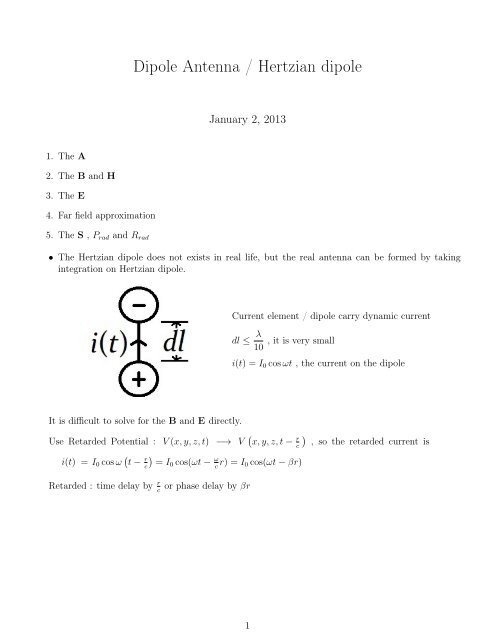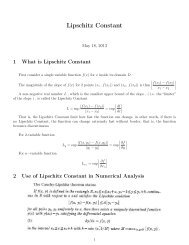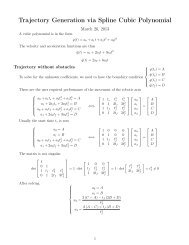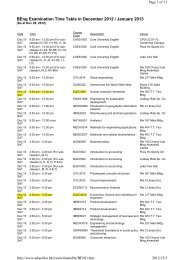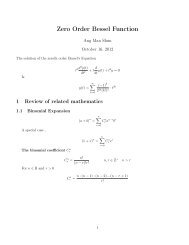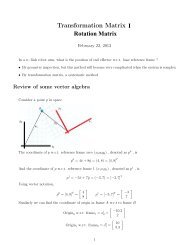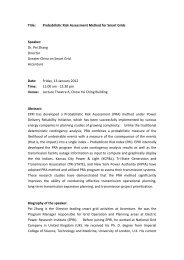Dipole Antenna / Hertzian dipole
Dipole Antenna / Hertzian dipole
Dipole Antenna / Hertzian dipole
Create successful ePaper yourself
Turn your PDF publications into a flip-book with our unique Google optimized e-Paper software.
<strong>Dipole</strong> <strong>Antenna</strong> / <strong>Hertzian</strong> <strong>dipole</strong><br />
January 2, 2013<br />
1. The A<br />
2. The B and H<br />
3. The E<br />
4. Far field approximation<br />
5. The S , P rad and R rad<br />
• The <strong>Hertzian</strong> <strong>dipole</strong> does not exists in real life, but the real antenna can be formed by taking<br />
integration on <strong>Hertzian</strong> <strong>dipole</strong>.<br />
Current element / <strong>dipole</strong> carry dynamic current<br />
dl ≤ λ 10<br />
, it is very small<br />
i(t) = I 0 cos ωt , the current on the <strong>dipole</strong><br />
It is difficult to solve for the B and E directly.<br />
Use Retarded Potential : V (x, y, z, t) −→ V ( )<br />
x, y, z, t − r c , so the retarded current is<br />
i(t) = I 0 cos ω ( t − c) r = I0 cos(ωt − ωr) = I c 0 cos(ωt − βr)<br />
Retarded : time delay by r c or phase delay by βr 1
1 The retarded magnetic vector potential<br />
In phasor form<br />
A(r, t) = µ[i(t)]dl<br />
4πr<br />
ẑ = µI0 cos ( t − ) r dl<br />
c ẑ<br />
4πr<br />
Ã(r) = µI 0dl<br />
4πr e−jβr ẑ<br />
( Recall ) Phasor transformation : V 0 cos (ωt + ϕ) = Re ( V 0 e j(ωt+ϕ)) = Re<br />
⎛<br />
⎞<br />
⎝V 0 e<br />
} {{ jϕ e<br />
}<br />
jωt ⎠<br />
P hasor<br />
For radiation by antenna, it is more convenient to select spherical coordinate system<br />
( Recall ) The coordinate transform of rectangular to spherical V (x, y, z) → V (r, θ, ϕ)<br />
Given vector ¯V = V xˆx + V y ŷ + V z ẑ , the vector representation in spherical coordinate is<br />
ˆV = (V x sin θ cos ϕ + V y sin θ sin ϕ + V z cos θ) ˆr+(−V x sin ϕ + V y cos ϕ) ˆϕ+(V x cos θ cos ϕ + V y cos θ sin ϕ − V z sin θ) ˆθ<br />
Since Ã(r) = µI 0<br />
4πr dl e−jβr ẑ = A z ẑ only, A x = A y = 0 , thus<br />
à = (A z cos θ) ˆr + (−A z sin θ) ˆθ<br />
= µI 0dl<br />
4πr cos θe−jβrˆr − µI 0dl<br />
4πr sin θe−jβr ˆθ<br />
( )<br />
cos θ<br />
= µI 0dl<br />
4π<br />
r<br />
e−jβrˆr − sin θ<br />
r<br />
e−jβr ˆθ<br />
• A(r, θ) is ϕ independent ⇐⇒<br />
∂<br />
∂ϕ = 0<br />
• A = A rˆr + A θ ˆθ ⇐⇒ Aϕ = 0<br />
2 B and H<br />
Find B by B = ∇ × A<br />
˜B = ∇ × Ã = ∣ ∣∣∣∣∣∣∣∣<br />
∣<br />
ˆr ˆθ ˆϕ ∣∣∣∣∣∣∣∣<br />
r 2 sin θ r sin θ r<br />
∂ ∂ ∂<br />
∂r ∂θ ∂ϕ<br />
A r rA θ r sin θA ϕ<br />
Since A is ϕ independent ⇒ ∂<br />
∂ϕ = 0 , and A ϕ = 0<br />
ˆr ˆθ ˆϕ<br />
∣ r<br />
˜B 2 sin θ r sin θ r<br />
=<br />
∂ ∂<br />
= 1 ∂ ∂ ∣∣∣∣ ( 1 ∂rAθ<br />
0<br />
r ∣<br />
∂r ∂θ ˆϕ = ∂r ∂θ<br />
A r rA θ<br />
r ∂r<br />
∣ A r rA θ 0 ∣<br />
2<br />
− ∂A )<br />
r ˆϕ<br />
∂θ
= µI 0dl<br />
4πr<br />
= 1 µI 0 dl<br />
r 4π<br />
(sin θjβ + e−jβr<br />
(<br />
− ∂ ∂r sin θe−jβr − ∂ )<br />
cos θ<br />
∂θ r e−jβr ˆϕ<br />
)<br />
sin θ ˆϕ = µI (<br />
0dl<br />
jβ<br />
r<br />
4π sin θe−jβr r + 1 )<br />
ˆϕ<br />
r 2<br />
Thus, by H = B µ<br />
˜H = I 0dl<br />
4π sin θe−jβr ( jβ<br />
r + 1 r 2 )<br />
ˆϕ<br />
• H r = H θ = 0<br />
• H(r, θ) is ϕ independent ⇐⇒<br />
∂<br />
∂ϕ = 0<br />
3 The E<br />
Find E by ε ∂E<br />
∂t = ∇ × H<br />
In phasor form, εjωẼ = ∇ × ˜H, thus<br />
Since H is ϕ independent ,<br />
Ẽ = 1<br />
jωε<br />
∣<br />
Ẽ = 1<br />
jωε ∇ × ˜H = 1<br />
jωε<br />
∣<br />
∂<br />
∂ϕ = 0 , and H r = H θ = 0<br />
∣<br />
ˆr ˆθ ˆϕ ∣∣∣∣∣∣∣∣<br />
(<br />
r 2 sin θ r sin θ r<br />
∂ ∂<br />
= 1<br />
0 jωε<br />
∂r ∂θ<br />
0 0 r sin θH ϕ<br />
H ϕ = I (<br />
0dl<br />
jβ<br />
4π sin θe−jβr r + 1 )<br />
r 2<br />
and thus<br />
∂r sin θH ϕ<br />
∂θ<br />
∣<br />
ˆr ˆθ ˆϕ ∣∣∣∣∣∣∣∣<br />
r 2 sin θ r sin θ r<br />
∂ ∂ ∂<br />
∂r ∂θ ∂ϕ<br />
H r rH θ r sin θH ϕ<br />
ˆr<br />
r 2 sin θ<br />
∂r sin θH ϕ<br />
∂θ<br />
, so r sin θH ϕ = I 0dl<br />
4π sin2 θe<br />
(jβ −jβr + 1 )<br />
r<br />
= I 0dl<br />
(jβ<br />
4π 2 sin θ cos θe−jβr + 1 )<br />
r<br />
−<br />
ˆθ<br />
r sin θ<br />
∂r sin θH ϕ<br />
∂r<br />
)<br />
∂r sin θH ϕ<br />
∂r<br />
= I (<br />
0dl<br />
4π sin2 θ<br />
[−jβe −jβr jβ + 1 ) ( )] −1<br />
+ e −jβr = I 0dl<br />
r<br />
r 2 4π sin2 θ<br />
[β 2 e −jβr − jβe−jβ<br />
r<br />
− e−jβr<br />
r 2 ]<br />
And therefore<br />
ˆr ∂r sin θH ϕ<br />
r 2 sin θ ∂θ<br />
= I 0dl<br />
2π cos θe−jβr ( jβ<br />
r 2 + 1 r 3 )<br />
ˆr<br />
3
ˆθ ∂r sin θH ϕ<br />
r sin θ ∂r<br />
= I [<br />
0dl β 2<br />
4π sin θ e −jβr<br />
r<br />
− jβe−jβr<br />
r 2<br />
− e−jβr<br />
r 3 ]<br />
ˆθ<br />
= 1<br />
ωε<br />
√ µ<br />
Since η =<br />
ϵ = β ωϵ<br />
• E ϕ = 0<br />
(<br />
Ẽ = 1<br />
jωε<br />
ˆr<br />
r 2 sin θ<br />
∂r sin θH ϕ<br />
∂θ<br />
−<br />
ˆθ<br />
r sin θ<br />
∂r sin θH ϕ<br />
∂r<br />
(<br />
I 0 dl<br />
β<br />
2π cos θe−jβr r − j )<br />
ˆr − 1<br />
[<br />
I 0 dl<br />
β<br />
2<br />
2 r 3 ωε 4π sin θe−jβr jr − β r − 1 ]<br />
ˆθ<br />
2 jr 3<br />
Ẽ = η I 0dl<br />
2π cos θe−jβr ( 1<br />
r 2 −<br />
j )<br />
ˆr + η I [<br />
0dl<br />
jβ<br />
βr 3 4π sin θe−jβr r + 1 r − 2<br />
)<br />
j ]<br />
ˆθ<br />
βr 3<br />
• E is ϕ independent ⇐⇒<br />
∂<br />
∂ϕ = 0<br />
4 Far Field Approximations<br />
Therefore the fields are<br />
Ẽ = η I 0dl<br />
2π cos θe−jβr ( 1<br />
r 2 −<br />
˜H = I 0dl<br />
4π sin θe−jβr ( jβ<br />
r + 1 r 2 )<br />
ˆϕ<br />
j )<br />
ˆr + η I [<br />
0dl<br />
jβ<br />
βr 3 4π sin θe−jβr r + 1 r − 2<br />
When r is large ( far field ) , ignore all the term with power ≥ 2<br />
j ]<br />
ˆθ<br />
βr 3<br />
In time domain<br />
˜H(r, θ) = I 0dl<br />
4π sin θe−jβr jβ r ˆϕ<br />
Ẽ(r, θ) = η I 0dl<br />
4π sin θ jβ r ˆθ<br />
H(r, θ, t) = − I 0βdl<br />
4πr<br />
sin θ sin (ωt − βr) ˆϕ Ẽ<br />
= −η I 0βdl<br />
4πr<br />
sin θ sin (ωt − βr) ˆθ<br />
5 Poynting Vector S , S avg , P rad and R rad<br />
The Poynting vector S in time domain is<br />
S = E × H = η I2 0β 2 dl 2<br />
16π 2 r 2 sin2 θ sin 2 (ωt − βr) ˆr<br />
The time-average Poynting vector in phasor domain is<br />
˜S avg = 1 ] [Ẽ<br />
2 Re × ˜H∗ = 1 2 Re [ ]<br />
E θ Hϕ<br />
∗ 1 ˆr =<br />
2 η|H ϕ| 2ˆr = η I2 0β 2 dl 2<br />
32π 2 r 2 sin2 θˆr<br />
Thus the time-average radiated power is<br />
4
( ) 2 2π<br />
• β 2 = = 4π2<br />
λ<br />
• ´ 2π<br />
dϕ = 2π<br />
ϕ=0<br />
‹<br />
ˆ 2π ˆ π<br />
( ηI<br />
2<br />
P rad = ˜S avg · d¯S =<br />
0 β 2 dl 2<br />
S<br />
ϕ=0 θ=0 32π 2 r 2<br />
λ 2<br />
= ηI2 0β 2 dl 2<br />
32π 2<br />
ˆ 2π<br />
• ´ π<br />
θ=0 sin3 θdθ = − ´ π<br />
θ=0 (1 − cos 2 θ) d cos θ = −<br />
P rad =<br />
ηI 2 0<br />
Special case, in free space, η 0 ≈ 120π<br />
ϕ=0<br />
ˆ π<br />
dϕ sin 3 θdθ<br />
θ=0<br />
[<br />
] π<br />
cos θ − cos3 θ<br />
3<br />
0<br />
( ) 4π<br />
2<br />
dl 2<br />
λ 2 2π · 4<br />
32π 2 3 = ηI2 0π<br />
3<br />
( ) 2 dl<br />
P rad = I040π 2 2 λ<br />
) (r<br />
sin 2 θ<br />
2 sin θdθdϕ )<br />
[<br />
= − −2 − −2 ]<br />
= 4 3 3<br />
( ) 2 dl<br />
λ<br />
Since P = I 2 R (for static) P = 1 2 I2 0R ( for dynamic ), thus the fictitious resistance, the radiation<br />
resistance R rad ( in free space ) is<br />
Where the general radiation resistance<br />
( ) 2 dl<br />
R rad = 80π 2 λ<br />
R rad = 2ηπ<br />
3<br />
( ) 2 dl<br />
λ<br />
5


